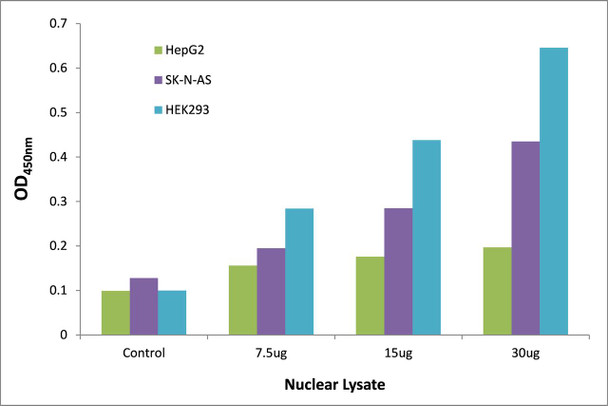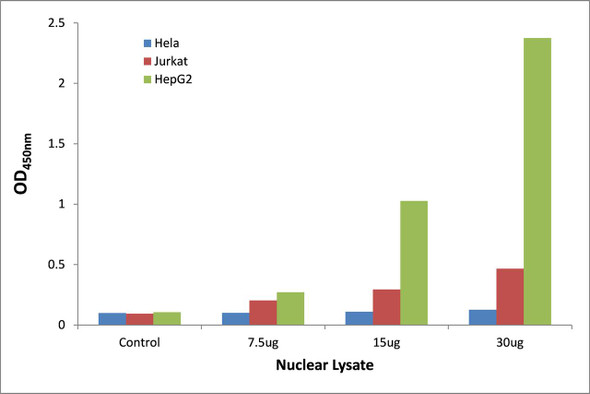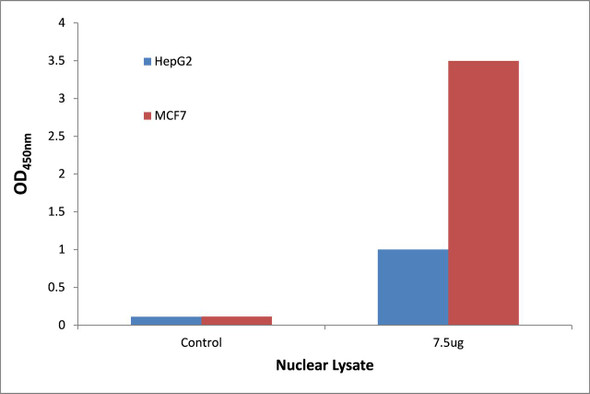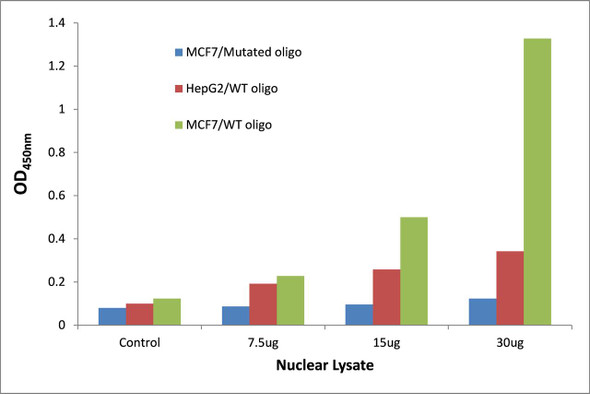Description
system_update_altDatasheet
| Product Name: | SIX5 Transcription Factor Activity Assay |
| Product Code: | TFAB00202 |
| Target: | SIX5 |
| Reactivity: | Human, Mouse |
| Sample Types: | Nuclear or cell lysates |
The Assay Genie SIX5 transcription factor activity assay allows for the detection and qualitative analysis of endogenous levels of activated transcription factors in a variety of nuclear and cell lysates
Assay Genie ELISA kits are designed to significantly reduce experiment time and ensure sensitivity and flexibility for high-throughput screening.
| Assay Time: | 4.5 hours |
| Detection Method: | Colorimetric 450 nm |
| Size: | 12 x 8-Well Microstrips |
| Storage: | 4°C for 6 months |
| UniProt Protein Function: | SIX5: Transcription factor that is thought to be involved in regulation of organogenesis. May be involved in determination and maintenance of retina formation. Binds a 5'-GGTGTCAG-3' motif present in the ARE regulatory element of ATP1A1. Binds a 5'- TCA[AG][AG]TTNC-3' motif present in the MEF3 element in the myogenin promoter, and in the IGFBP5 promoter. Thought to be regulated by association with Dach and Eya proteins, and seems to be coactivated by EYA1, EYA2 and EYA3. Defects in SIX5 are the cause of branchiootorenal syndrome type 2 (BOR2). BOR is an autosomal dominant disorder manifested by various combinations of preauricular pits, branchial fistulae or cysts, lacrimal duct stenosis, hearing loss, structural defects of the outer, middle, or inner ear, and renal dysplasia. Associated defects include asthenic habitus, long narrow facies, constricted palate, deep overbite, and myopia. Hearing loss may be due to mondini type cochlear defect and stapes fixation. Penetrance of BOR syndrome is high, although expressivity can be extremely variable. Belongs to the SIX/Sine oculis homeobox family. |
| UniProt Protein Details: | Protein type:Transcription factor; DNA-binding Chromosomal Location of Human Ortholog: 19q13.32 Cellular Component: cytoplasm; Golgi apparatus; intracellular membrane-bound organelle; nucleoplasm Molecular Function:protein binding Disease: Branchiootorenal Syndrome 2 |
| NCBI Summary: | The protein encoded by this gene is a homeodomain-containing transcription factor that appears to function in the regulation of organogenesis. This gene is located downstream of the dystrophia myotonica-protein kinase gene. Mutations in this gene are a cause of branchiootorenal syndrome type 2. [provided by RefSeq, Jul 2009] |
| UniProt Code: | Q8N196 |
| NCBI GenInfo Identifier: | 150421671 |
| NCBI Gene ID: | 147912 |
| NCBI Accession: | Q8N196.3 |
| UniProt Related Accession: | Q8N196 |
| Molecular Weight: | 74,562 Da |
| NCBI Full Name: | Homeobox protein SIX5 |
| NCBI Synonym Full Names: | SIX homeobox 5 |
| NCBI Official Symbol: | SIX5 |
| NCBI Official Synonym Symbols: | BOR2; DMAHP |
| NCBI Protein Information: | homeobox protein SIX5 |
| UniProt Protein Name: | Homeobox protein SIX5 |
| UniProt Synonym Protein Names: | DM locus-associated homeodomain protein; Sine oculis homeobox homolog 5 |
| Protein Family: | Homeobox protein |
| UniProt Gene Name: | SIX5 |
| UniProt Entry Name: | SIX5_HUMAN |






